check engine light Alfa Romeo Giulietta 2011 Owner handbook (in English)
[x] Cancel search | Manufacturer: ALFA ROMEO, Model Year: 2011, Model line: Giulietta, Model: Alfa Romeo Giulietta 2011Pages: 297, PDF Size: 9.37 MB
Page 163 of 297
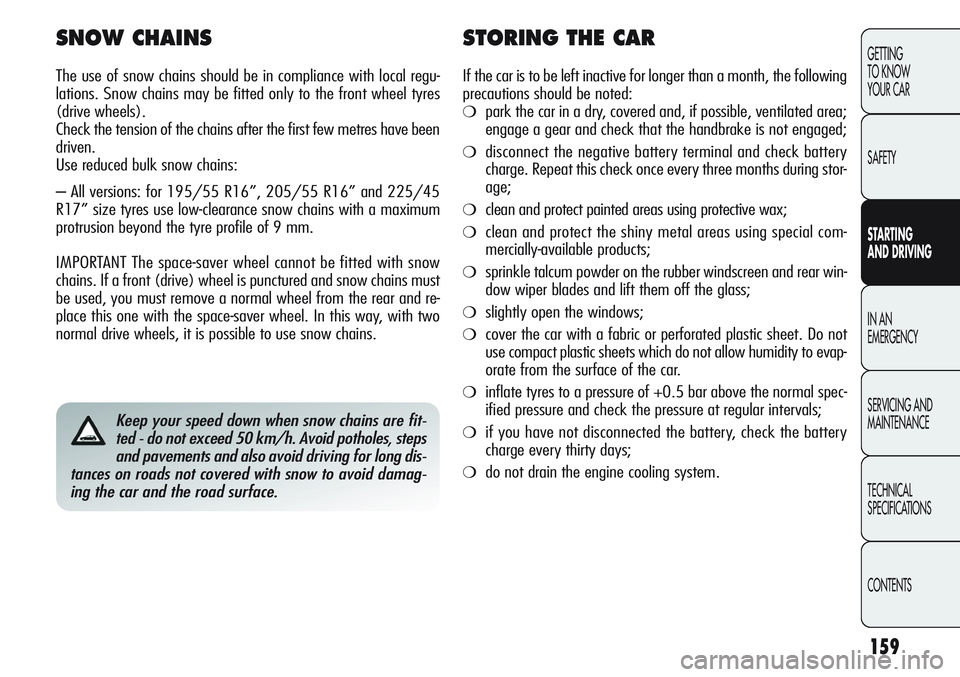
159
GETTING
TO KNOW
YOUR CAR
SAFETY
STARTING
AND DRIVING
IN AN
EMERGENCY
SERVICING AND
MAINTENANCE
TECHNICAL
SPECIFICATIONS
CONTENTS
Keep your speed down when snow chains are fit-
ted - do not exceed 50 km/h. Avoid potholes, steps
and pavements and also avoid driving for long dis-
tances on roads not covered with snow to avoid damag-
ing the car and the road surface.
SNOW CHAINS
The use of snow chains should be in compliance with local regu-
lations. Snow chains may be fitted only to the front wheel tyres
(drive wheels).
Check the tension of the chains after the first few metres have been
driven.
Use reduced bulk snow chains:
– All versions: for 195/55 R16”, 205/55 R16” and 225/45
R17” size tyres use low-clearance snow chains with a maximum
protrusion beyond the tyre profile of 9 mm.
IMPORTANT The space-saver wheel cannot be fitted with snow
chains. If a front (drive) wheel is punctured and snow chains must
be used, you must remove a normal wheel from the rear and re-
place this one with the space-saver wheel. In this way, with two
normal drive wheels, it is possible to use snow chains.
STORING THE CAR
If the car is to be left inactive for longer than a month, the following
precautions should be noted:
❍park the car in a dry, covered and, if possible, ventilated area;
engage a gear and check that the handbrake is not engaged;
❍disconnect the negative battery terminal and check battery
charge. Repeat this check once every three months during stor-
age;
❍clean and protect painted areas using protective wax;
❍clean and protect the shiny metal areas using special com-
mercially-available products;
❍sprinkle talcum powder on the rubber windscreen and rear win-
dow wiper blades and lift them off the glass;
❍slightly open the windows;
❍cover the car with a fabric or perforated plastic sheet. Do not
use compact plastic sheets which do not allow humidity to evap-
orate from the surface of the car.
❍inflate tyres to a pressure of +0.5 bar above the normal spec-
ified pressure and check the pressure at regular intervals;
❍if you have not disconnected the battery, check the battery
charge every thirty days;
❍do not drain the engine cooling system.
Page 204 of 297

200
GETTING
TO KNOW
YOUR CAR
SAFETY
STARTING
AND DRIVING
IN AN
EMERGENCY
SERVICING AND
MAINTENANCE
TECHNICAL
SPECIFICATIONS
CONTENTS
SCHEDULED SERVICING PLAN
1.4 Turbo Petrol and 1.4 Turbo Multi Air VERSIONS
Thousands of miles
Thousands of km
Months
Check tyre condition/wear and adjust pressure if required
Check lighting system operation (headlights, direction indicators, hazard lights, passenger
compartment lights, boot lights, instrument panel warning lights, etc.)
Check windscreen wiper/washer operation
Check the position/wear of the windscreen/rear window wiper blades
Check condition and wear of front disc brake pads and
operation of pad wear indicator
Check rear disc brake pad condition and wear
Conditions and visual check: bodywork exterior, underbody protection,
pipes and hoses (exhaust - fuel system - braking system),
rubber elements (boots - sleeves - bushes - etc.)
Check cleanliness of bonnet and boot locks,
as well as cleanliness and lubrication of linkages
Check and top up, if required, fluid levels
(engine coolant, brake/hydraulic clutch fluid, windscreen washer fluid, battery fluid, etc)
Check the handbrake lever travel and adjust it, if necessary
Check condition of timing belt
Visually inspect the condition of accessory drive belt(s)
Check exhaust gas emissions
Check battery charge status and possibly recharge18 36 54 72 90 108
30 60 90 120 150 180
24 48 72 96 120 144
●●● ●●●
●●● ●●●
●●● ●●●
●●● ●●●
●●● ●●●
●●● ●●●
●●● ●●●
●●● ●●●
●●● ●●●
●●● ●●●
●●
●●
●●● ●●●
●●● ●●●
Page 206 of 297
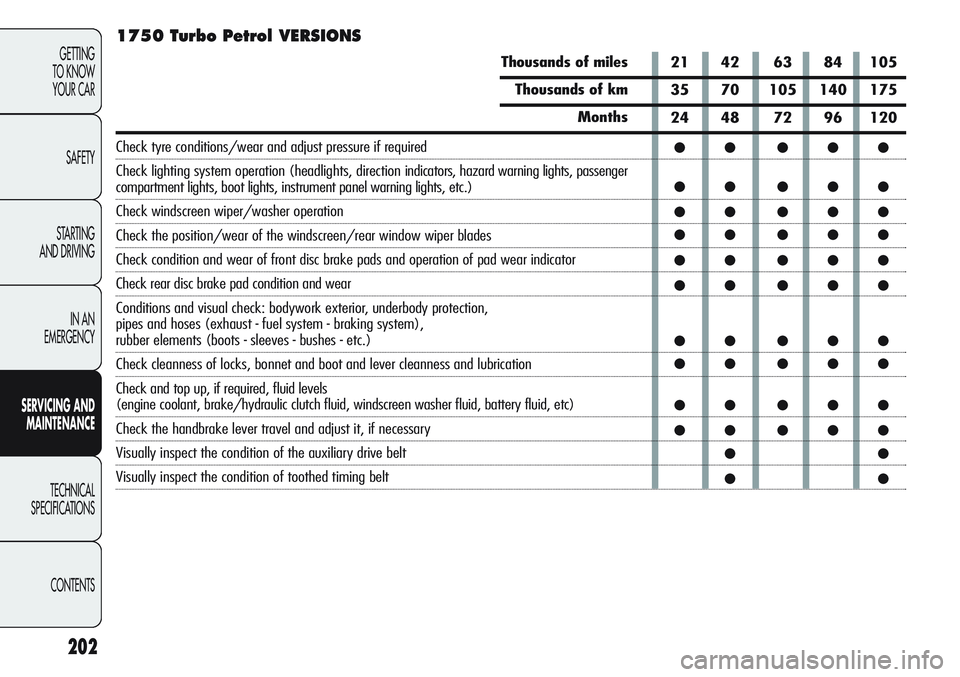
21 42 63 84 105
35 70 105 140 175
24 48 72 96 120
●● ●●●
●● ●●●
●● ●●●
●● ●●●
●● ●●●
●● ●●●
●● ●●●
●● ●●●
●● ●●●
●● ●●●
●●
●●
202
GETTING
TO KNOW
YOUR CAR
SAFETY
STARTING
AND DRIVING
IN AN
EMERGENCY
SERVICING AND
MAINTENANCE
TECHNICAL
SPECIFICATIONS
CONTENTS
1750 Turbo Petrol VERSIONS
Thousands of miles
Thousands of km
Months
Check tyre conditions/wear and adjust pressure if required
Check lighting system operation (headlights, direction indicators, hazard warning lights, passenger
compartment lights, boot lights, instrument panel warning lights, etc.)
Check windscreen wiper/washer operation
Check the position/wear of the windscreen/rear window wiper blades
Check condition and wear of front disc brake pads and operation of pad wear indicator
Check rear disc brake pad condition and wear
Conditions and visual check: bodywork exterior, underbody protection,
pipes and hoses (exhaust - fuel system - braking system),
rubber elements (boots - sleeves - bushes - etc.)
Check cleanness of locks, bonnet and boot and lever cleanness and lubrication
Check and top up, if required, fluid levels
(engine coolant, brake/hydraulic clutch fluid, windscreen washer fluid, battery fluid, etc)
Check the handbrake lever travel and adjust it, if necessary
Visually inspect the condition of the auxiliary drive belt
Visually inspect the condition of toothed timing belt
Page 207 of 297
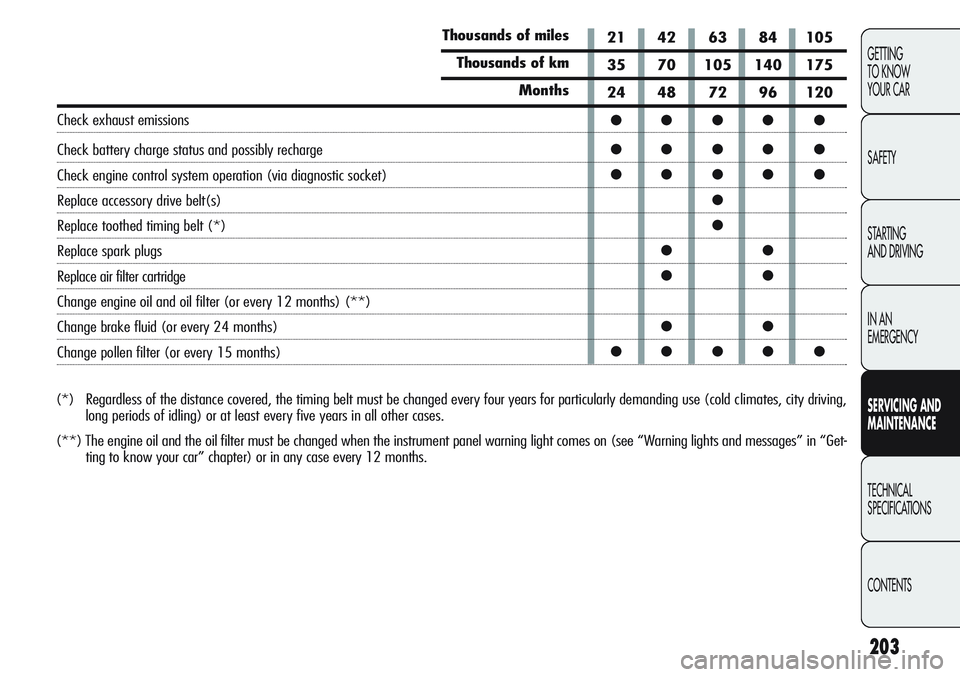
203
GETTING
TO KNOW
YOUR CAR
SAFETY
STARTING
AND DRIVING
IN AN
EMERGENCY
SERVICING AND
MAINTENANCE
TECHNICAL
SPECIFICATIONS
CONTENTS
(*) Regardless of the distance covered, the timing belt must be changed every four years for particularly demanding use (cold climates, city driving,
long periods of idling) or at least every five years in all other cases.
(**) The engine oil and the oil filter must be changed when the instrument panel warning light comes on (see “Warning lights and messages” in “Get-
ting to know your car” chapter) or in any case every 12 months.
Thousands of miles
Thousands of km
Months
Check exhaust emissions
Check battery charge status and possibly recharge
Check engine control system operation (via diagnostic socket)
Replace accessory drive belt(s)
Replace toothed timing belt (*)
Replace spark plugs
Replace air filter cartridge
Change engine oil and oil filter (or every 12 months) (**)
Change brake fluid (or every 24 months)
Change pollen filter (or every 15 months)21 42 63 84 105
35 70 105 140 175
24 48 72 96 120
●● ●● ●
●● ●● ●
●● ●● ●
●
●
●●
●●
●●
●● ●● ●
Page 208 of 297

204
GETTING
TO KNOW
YOUR CAR
SAFETY
STARTING
AND DRIVING
IN AN
EMERGENCY
SERVICING AND
MAINTENANCE
TECHNICAL
SPECIFICATIONS
CONTENTS
Thousands of miles
Thousands of km
Months
Check tyre condition/wear and adjust pressure if required
Check operation of lighting system (headlights, direction indicators, hazard warning lights,
luggage compartment, passenger compartment, instrument panel warning lights, etc.)
Check windscreen wiper/washer operation
Check the position/wear of the windscreen/rear window wiper blades
Check condition and wear of front disc brake pads and operation of pad wear indicator
Check rear disc brake pad condition and wear
Conditions and visual check: bodywork exterior, underbody protection,
pipes and hoses (exhaust - fuel system - braking system),
rubber elements (boots - sleeves - bushes - etc.)
Check cleanliness of bonnet and boot locks, as well as cleanliness and lubrication of linkages
Check and top up, if required, fluid levels
(engine coolant, brake/hydraulic clutch fluid, windscreen washer fluid, battery fluid, etc)
Check the handbrake lever travel and adjust it, if necessary
Check exhaust fumes/emissions
Check battery charge status and possibly recharge
Visually inspect the condition of the auxiliary drive belt
Check engine control system operation (via diagnostic socket)21 42 63 84 105
35 70 105 140 175
24 48 72 96 120
●● ● ●●
●● ●● ●
●● ●● ●
●● ●● ●
●● ●● ●
●● ●● ●
●● ●● ●
●● ●● ●
●● ●● ●
●● ●● ●
●● ●● ●
●● ●● ●
●●
●● ●● ●
Diesel VERSIONS
Page 210 of 297
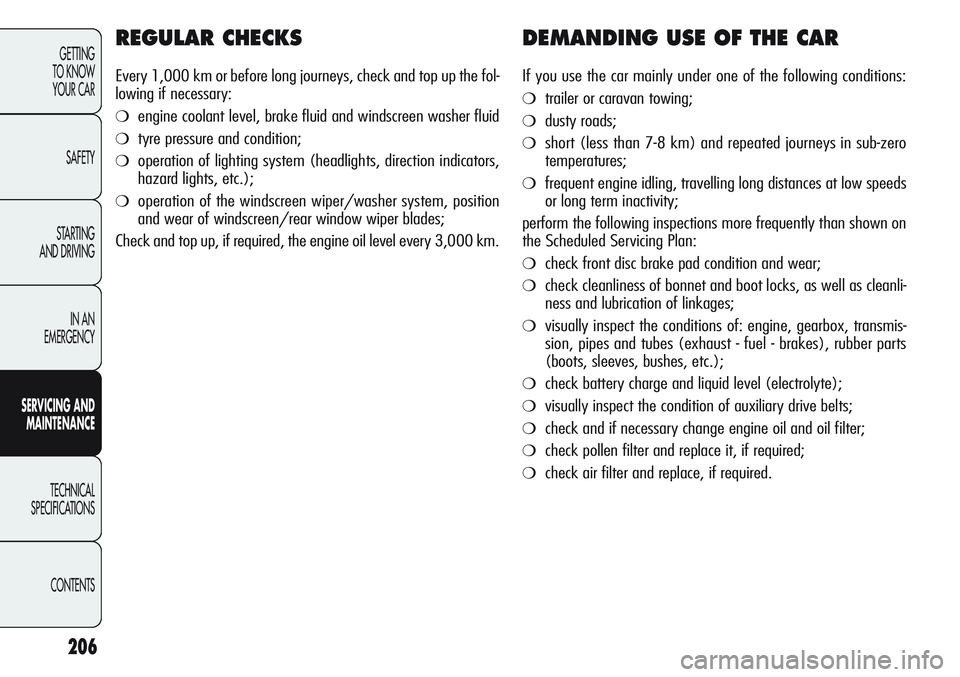
206
GETTING
TO KNOW
YOUR CAR
SAFETY
STARTING
AND DRIVING
IN AN
EMERGENCY
SERVICING AND
MAINTENANCE
TECHNICAL
SPECIFICATIONS
CONTENTS
REGULAR CHECKS
Every 1,000 km or before long journeys, check and top up the fol-
lowing if necessary:
❍engine coolant level, brake fluid and windscreen washer fluid
❍tyre pressure and condition;
❍operation of lighting system (headlights, direction indicators,
hazard lights, etc.);
❍operation of the windscreen wiper/washer system, position
and wear of windscreen/rear window wiper blades;
Check and top up, if required, the engine oil level every 3,000 km.
DEMANDING USE OF THE CAR
If you use the car mainly under one of the following conditions:
❍trailer or caravan towing;
❍dusty roads;
❍short (less than 7-8 km) and repeated journeys in sub-zero
temperatures;
❍frequent engine idling, travelling long distances at low speeds
or long term inactivity;
perform the following inspections more frequently than shown on
the Scheduled Servicing Plan:
❍check front disc brake pad condition and wear;
❍check cleanliness of bonnet and boot locks, as well as cleanli-
ness and lubrication of linkages;
❍visually inspect the conditions of: engine, gearbox, transmis-
sion, pipes and tubes (exhaust - fuel - brakes), rubber parts
(boots, sleeves, bushes, etc.);
❍check battery charge and liquid level (electrolyte);
❍visually inspect the condition of auxiliary drive belts;
❍check and if necessary change engine oil and oil filter;
❍check pollen filter and replace it, if required;
❍check air filter and replace, if required.
Page 217 of 297
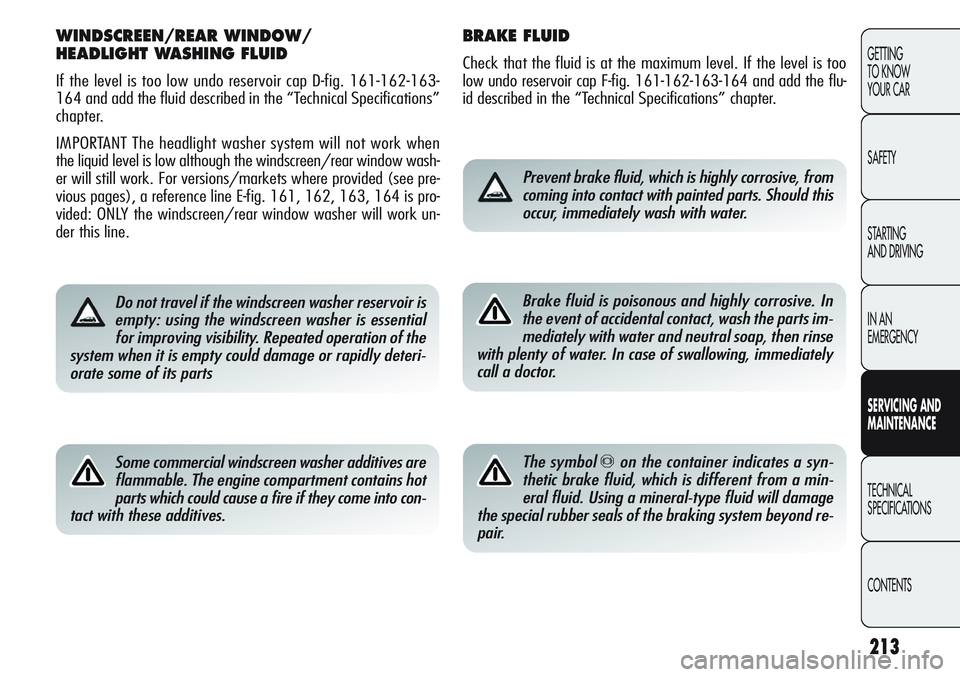
213
GETTING
TO KNOW
YOUR CAR
SAFETY
STARTING
AND DRIVING
IN AN
EMERGENCY
SERVICING AND
MAINTENANCE
TECHNICAL
SPECIFICATIONS
CONTENTS
BRAKE FLUID
Check that the fluid is at the maximum level. If the level is too
low undo reservoir cap F-fig. 161-162-163-164 and add the flu-
id described in the “Technical Specifications” chapter.
Prevent brake fluid, which is highly corrosive, from
coming into contact with painted parts. Should this
occur, immediately wash with water.
WINDSCREEN/REAR WINDOW/
HEADLIGHT WASHING FLUID
If the level is too low undo reservoir cap D-fig. 161-162-163-
164 and add the fluid described in the “Technical Specifications”
chapter.
IMPORTANT The headlight washer system will not work when
the liquid level is low although the windscreen/rear window wash-
er will still work. For versions/markets where provided (see pre-
vious pages), a reference line E-fig. 161, 162, 163, 164 is pro-
vided: ONLY the windscreen/rear window washer will work un-
der this line.
Some commercial windscreen washer additives are
flammable. The engine compartment contains hot
parts which could cause a fire if they come into con-
tact with these additives.
Brake fluid is poisonous and highly corrosive. In
the event of accidental contact, wash the parts im-
mediately with water and neutral soap, then rinse
with plenty of water. In case of swallowing, immediately
call a doctor.
The symbol πon the container indicates a syn-
thetic brake fluid, which is different from a min-
eral fluid. Using a mineral-type fluid will damage
the special rubber seals of the braking system beyond re-
pair.
Do not travel if the windscreen washer reservoir is
empty: using the windscreen washer is essential
for improving visibility. Repeated operation of the
system when it is empty could damage or rapidly deteri-
orate some of its parts
Page 218 of 297
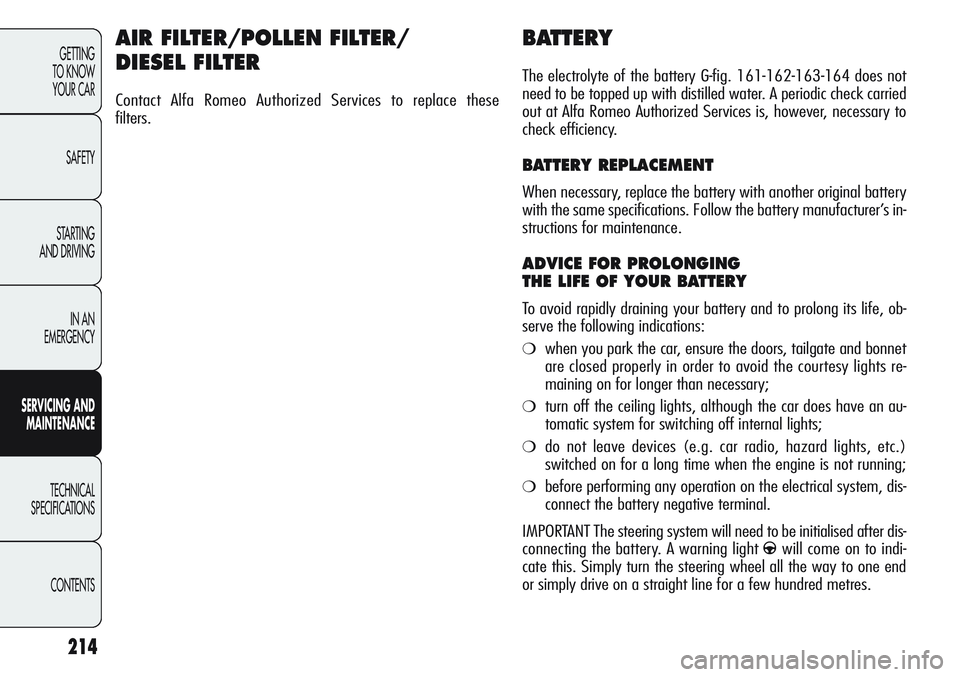
214
GETTING
TO KNOW
YOUR CAR
SAFETY
STARTING
AND DRIVING
IN AN
EMERGENCY
SERVICING AND
MAINTENANCE
TECHNICAL
SPECIFICATIONS
CONTENTS
BATTERY
The electrolyte of the battery G-fig. 161-162-163-164 does not
need to be topped up with distilled water. A periodic check carried
out at Alfa Romeo Authorized Services is, however, necessary to
check efficiency.
BATTERY REPLACEMENT
When necessary, replace the battery with another original battery
with the same specifications. Follow the battery manufacturer’s in-
structions for maintenance.
ADVICE FOR PROLONGING
THE LIFE OF YOUR BATTERY
To avoid rapidly draining your battery and to prolong its life, ob-
serve the following indications:
❍when you park the car, ensure the doors, tailgate and bonnet
are closed properly in order to avoid the courtesy lights re-
maining on for longer than necessary;
❍turn off the ceiling lights, although the car does have an au-
tomatic system for switching off internal lights;
❍do not leave devices (e.g. car radio, hazard lights, etc.)
switched on for a long time when the engine is not running;
❍before performing any operation on the electrical system, dis-
connect the battery negative terminal.
IMPORTANT The steering system will need to be initialised after dis-
connecting the battery. A warning light
gwill come on to indi-
cate this. Simply turn the steering wheel all the way to one end
or simply drive on a straight line for a few hundred metres.
AIR FILTER/POLLEN FILTER/
DIESEL FILTER
Contact Alfa Romeo Authorized Services to replace these
filters.
Page 290 of 297
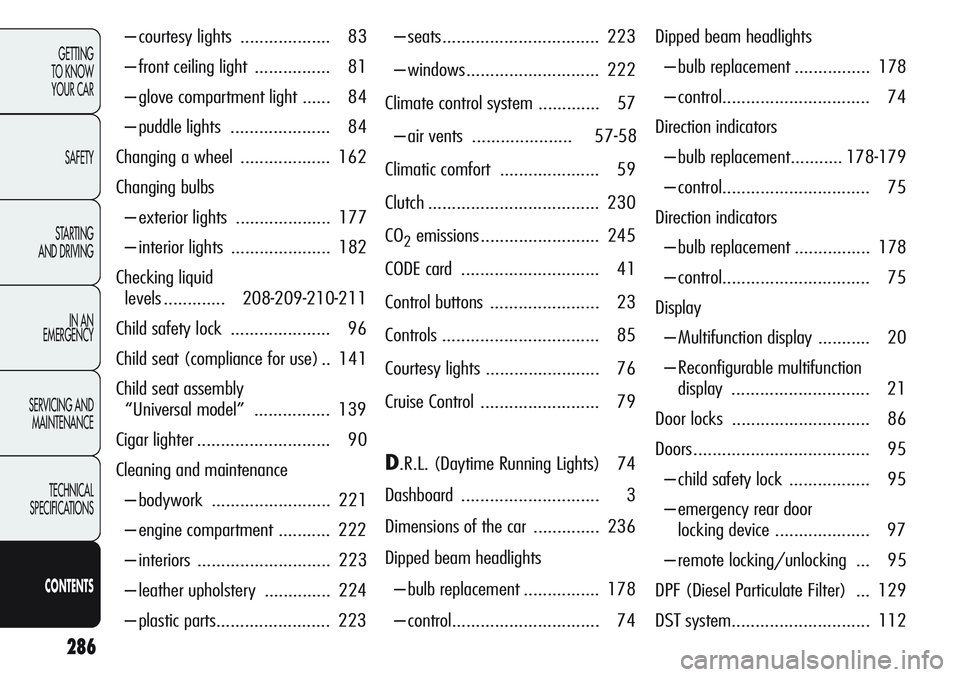
286
GETTING
TO KNOW
YOUR CAR
SAFETY
STARTING
AND DRIVING
IN AN
EMERGENCY
SERVICING AND
MAINTENANCE
TECHNICAL
SPECIFICATIONS
CONTENTS
– courtesy lights ................... 83
– front ceiling light ................ 81
– glove compartment light ...... 84
– puddle lights ..................... 84
Changing a wheel ................... 162
Changing bulbs
– exterior lights .................... 177
– interior lights ..................... 182
Checking liquid
levels .............208-209-210-211
Child safety lock ..................... 96
Child seat (compliance for use) .. 141
Child seat assembly
“Universal model” ................ 139
Cigar lighter............................ 90
Cleaning and maintenance
– bodywork ......................... 221
– engine compartment ........... 222
– interiors ............................ 223
– leather upholstery .............. 224
– plastic parts........................ 223– seats................................. 223
– windows............................ 222
Climate control system ............. 57
– air vents .....................57-58
Climatic comfort ..................... 59
Clutch .................................... 230
CO
2emissions ......................... 245
CODE card ............................. 41
Control buttons ....................... 23
Controls................................. 85
Courtesy lights ........................ 76
Cruise Control ......................... 79
D.R.L. (Daytime Running Lights) 74
Dashboard............................. 3
Dimensions of the car .............. 236
Dipped beam headlights
– bulb replacement ................ 178
– control............................... 74Dipped beam headlights
– bulb replacement ................ 178
– control............................... 74
Direction indicators
– bulb replacement........... 178-179
– control............................... 75
Direction indicators
– bulb replacement ................ 178
– control............................... 75
Display
– Multifunction display ........... 20
– Reconfigurable multifunction
display ............................. 21
Door locks ............................. 86
Doors..................................... 95
– child safety lock ................. 95
– emergency rear door
locking device .................... 97
– remote locking/unlocking ... 95
DPF (Diesel Particulate Filter) ... 129
DST system............................. 112
Page 291 of 297
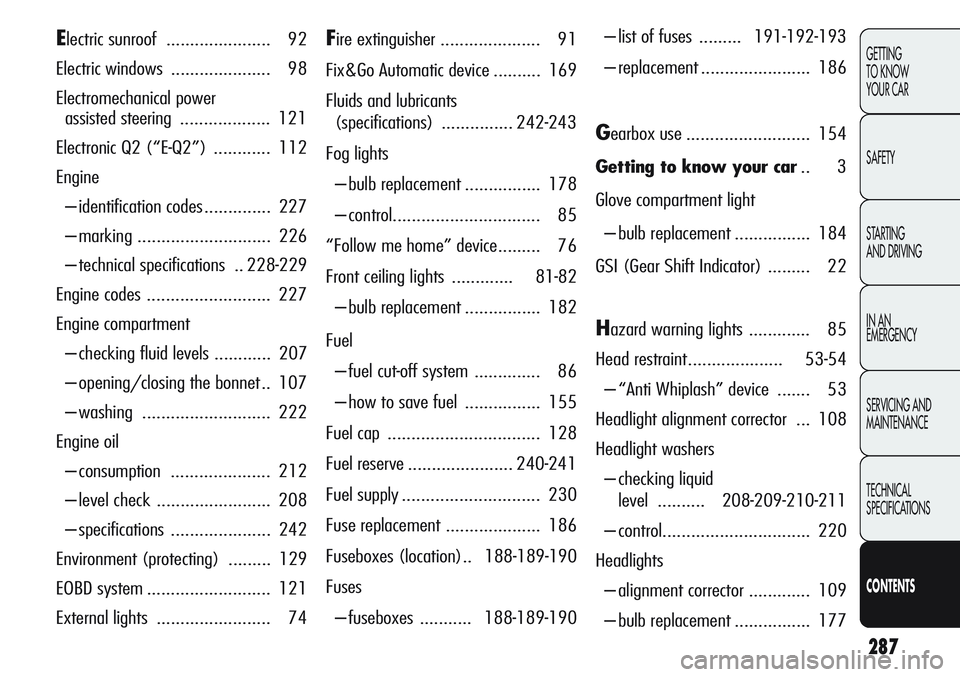
287
GETTING
TO KNOW
YOUR CAR
SAFETY
STARTING
AND DRIVING
IN AN
EMERGENCY
SERVICING AND
MAINTENANCE
TECHNICAL
SPECIFICATIONS
CONTENTS
Electric sunroof ...................... 92
Electric windows ..................... 98
Electromechanical power
assisted steering................... 121
Electronic Q2 (“E-Q2”) ............ 112
Engine
– identification codes .............. 227
– marking ............................ 226
– technical specifications .. 228-229
Engine codes .......................... 227
Engine compartment
– checking fluid levels ............ 207
– opening/closing the bonnet .. 107
– washing ........................... 222
Engine oil
– consumption ..................... 212
– level check ........................ 208
– specifications ..................... 242
Environment (protecting) ......... 129
EOBD system .......................... 121
External lights ........................ 74Fire extinguisher ..................... 91
Fix&Go Automatic device .......... 169
Fluids and lubricants
(specifications)...............242-243
Fog lights
– bulb replacement ................ 178
– control............................... 85
“Follow me home” device......... 76
Front ceiling lights ............. 81-82
– bulb replacement ................ 182
Fuel
– fuel cut-off system .............. 86
– how to save fuel ................ 155
Fuel cap ................................ 128
Fuel reserve ......................240-241
Fuel supply............................. 230
Fuse replacement .................... 186
Fuseboxes (location).. 188-189-190
Fuses
– fuseboxes ........... 188-189-190– list of fuses ......... 191-192-193
– replacement ....................... 186
Gearbox use.......................... 154
Getting to know your car.. 3
Glove compartment light
– bulb replacement ................ 184
GSI (Gear Shift Indicator) ......... 22
Hazard warning lights ............. 85
Head restraint.................... 53-54
– “Anti Whiplash” device ....... 53
Headlight alignment corrector ... 108
Headlight washers
– checking liquid
level ..........208-209-210-211
– control............................... 220
Headlights
– alignment corrector ............. 109
– bulb replacement ................ 177